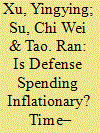|
|
|
Sort Order |
|
|
|
Items / Page
|
|
|
|
|
|
|
| Srl | Item |
| 1 |
ID:
186911


|
|
|
|
|
| Summary/Abstract |
This paper aims to describe and explain the different morphosyntactic and semantic features of some double verb constructions in Persian, an Indo-European language mainly spoken in Iran. It is argued that these double verb constructions are not instances of serial verb construction, but instances of emerging aspectual verbs with varied degrees of grammaticalization. It is argued that numerous factors lead to grammaticalization of these verbs, including context, the semantic class of the verbs, and their frequency. A corpus-based analysis shows that these aspectual verbs have been grammaticalized in different ratios during the last one hundred years, demonstrating ongoing change in the Persian language.
|
|
|
|
|
|
|
|
|
|
|
|
|
|
|
|
| 2 |
ID:
149604


|
|
|
|
|
| Summary/Abstract |
ABSTRACT
Bayesian methods are used to compare the predictions of probabilistic risk assessment—the theoretical tool used by the nuclear industry to predict the frequency of nuclear accidents—with empirical data. The existing record of accidents with some simplifying assumptions regarding their probability distribution is sufficient to rule out the validity of the industry’s analyses at a very high confidence level. This conclusion is shown to be robust against any reasonable assumed variation of safety standards over time, and across regions. The debate on nuclear liability indicates that the industry has independently arrived at this conclusion. Paying special attention to the case of India, the article shows that the existing operating experience provides insufficient data to make any reliable claims about the safety of future reactors. Finally, policy implications of the article findings are briefly discussed.
|
|
|
|
|
|
|
|
|
|
|
|
|
|
|
|
| 3 |
ID:
171075


|
|
|
|
|
| Summary/Abstract |
This study examines the nexus between the defense spending growth rate and inflation to test whether defense spending is inflationary in China, particularly in times of peace. Using wavelet analysis, we find that the linkage between the defense spending growth rate and inflation changes over time and across frequencies. We provide evidence supporting negative leading effects of inflation on the defense spending growth rate in certain periods across various frequencies. The results illustrate that the relationship is stronger at the short- to medium-term horizon of less than eight years than it is in the long term. No positive leading effect of defense spending on inflation is demonstrated, showing that defense spending is not inflationary in China. The results indicate that inflation lowers the defense spending growth rate at short and medium scales, particularly in peace time. This study provides new insights into the nexus between defense spending and inflation and emphasizes that such a correlation has time and frequency features. Meanwhile, given that there is little evidence supporting the idea that defense spending is inflationary, a moderate increase in defense spending will not damage price stability in China.
|
|
|
|
|
|
|
|
|
|
|
|
|
|
|
|
| 4 |
ID:
156159


|
|
|
|
|
| Summary/Abstract |
To leverage the full range of observed variation in patterns of violence toward the development and testing of theories of political violence, scholars need adequate conceptual foundations: what should we mean by a pattern of violence on the part of an armed organization? Scholars often distinguish degrees or levels or types of violence across organizations and conflicts, but definitions and measures vary sharply. We argue that patterns of violence are not reducible in ways often assumed in the literature: lethal violence is not a good proxy for the overall pattern, and differences in patterns are not well captured in the binary “terror” versus “restraint.” To address these concerns, we provide a new conceptualization of political violence, defining an organization’s pattern of violence as the configuration of repertoire, targeting, frequency, and technique in which it regularly engages. This approach adds precision to the documentation and analysis of political violence, clarifies the evaluation of rival theories, and opens up new research questions. We demonstrate its utility through an analysis of violence against civilians in Colombia, drawing on an original database of massacres, judicial proceedings, and other sources, and show that the concept of “pattern” helps bring ideology and politics back into the analysis of organized violence.
|
|
|
|
|
|
|
|
|
|
|
|
|
|
|
|
|
|
|
|
|